Mew VMAX needs no introduction. One of the best decks in the game since its release in Fusion Strike, it has had a consistent presence over time, getting top 8 after top 8, winning multiple Regional Championships, Japan’s Nationals, and of course, the 2023 World Championships. If you’ve played Pokémon at any point during the last two years, you’ve played against Mew VMAX.
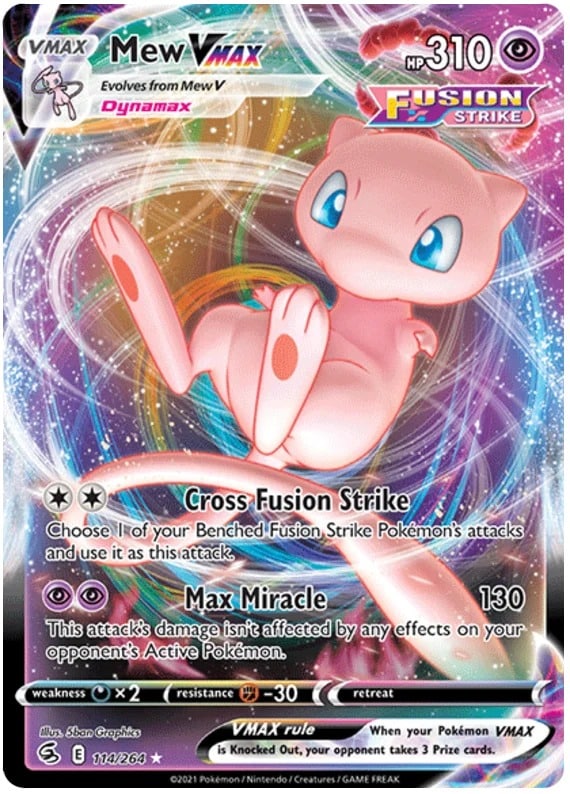
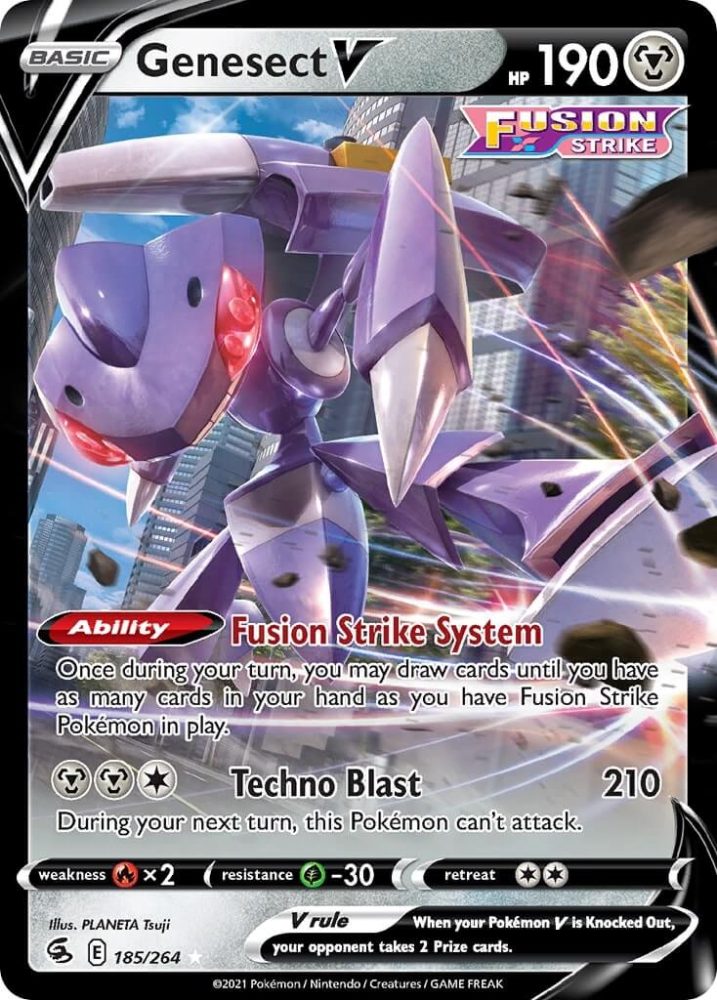
Like many other archetypes that have persisted over a long time, Mew VMAX is not a monolith. Zoroark GX and Arceus VSTAR, for example, two of the decks that have had a lasting impact on the game, could be described not as an archetype but as a collection of archetypes. Due to the self-reinforcing nature of the Fusion Strike mechanic, where Fusion Strike cards need other Fusion Strike cards to work efficiently (think of how Mew VMAX needs other Fusion Strike Pokémon to copy attacks from, or how Genesect V’s Ability works better the more Fusion Strike Pokémon you have in play), Mew VMAX decklists can’t branch out too much, even compared to the other Battle Styles. (Single Strike Pokémon like Duraludon VMAX, for example, have been played in archetypes where their Single Strike tag mattered little; you can’t say the same about Mew VMAX.) To an extent, Mew VMAX lists will look alike, because they all need to include key cards like Genesect V and Power Tablet, not to mention staples that fit the deck perfectly, like Ultra Ball and Battle VIP Pass.
Yet, over the years, the deck has forked into two different variants, which do have many cards in common but play a bit differently: the Fusion variant, which includes Elesa’s Sparkle, Fusion Strike Energy, and Meloetta (and often Eiscue nowadays), and the Fusionless or DTE variant, which only plays Double Turbo Energy and has more of a focus on disruption; while early builds of this deck used PokéStop and Item cards such as Cross Switcher, for a long time this variant has been known for its use of disruptive cards such as Judge (formerly Marnie) and Path to the Peak.
I’m sure that most of you are familiar with these two variants, so I don’t need to detail their whole history, but I do want to point out that which variant was considered better varied vastly over time. At the beginning, the Fusion variant was considered better because it had the option of attacking on turn 1, which was especially important in the Mew mirror match. Then, the DTE variant slowly took over during the Lost Origin and Silver Tempest formats, as it performed better against important matchups like Lost Box and Lugia VSTAR.
A huge shift occurred in June 2023, upon Paldea Evolved‘s release: the new Spiritomb was the perfect counter to Mew VMAX, and the only way to deal with it was to play Fusion Strike Energy on a Genesect V to protect it against Spiritomb’s Ability. Hence, the Fusion variant suddenly shot up in popularity. At NAIC and Worlds, almost every Mew player was running the Fusion version of the deck.
Then, as Obsidian Flames released, Mew VMAX had to deal with another problem: Charizard ex. The Fusion version was fairly powerless to deal with it so, as Charizard ex gained popularity, Mew players switched back to the DTE version, which had better chances against Charizard thanks to cards like Path to the Peak, Box of Disaster, and after the small set Pokémon 151 released, Grabber (sometimes coupled with Luxray V). In the most recent Regionals, I believe that the DTE variant has been slightly more popular, but the Fusion version has also had strong results, including a top 4 finish at Portland.
Towards a reunion?
Generally speaking, the two versions of Mew both have some pros and cons. The DTE version has more disruption, so it can more easily threaten a wide variety of decks. Path to the Peak, especially combined with Judge or Iono, hurts most of the metagame, from top tier archetypes like Miraidon and Charizard to decks that are more fringe, like Gholdengo ex. By having no low HP Pokémon, DTE Mew is also more dangerous to Lost Zone decks: since there’s no Meloetta to KO, they can’t count on a 1-2-3 Prize map. Also, generally speaking, the deck runs better, since cards like Fusion Strike Energy and Elesa’s Sparkle can otherwise clog hands.
On the other hand, it’s hurt a lot by Spiritomb, which can easily be teched in many archetypes. Fusion Mew is much more resilient to Spiritomb, and it can attack on turn 1, which can be very strong in the mirror match, as well as against decks with two-Prize Basic Pokémon, like Miraidon.
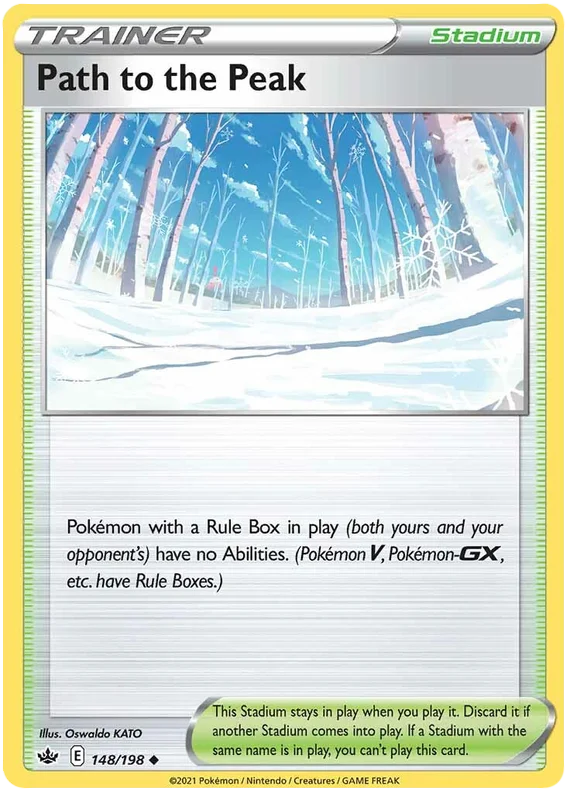
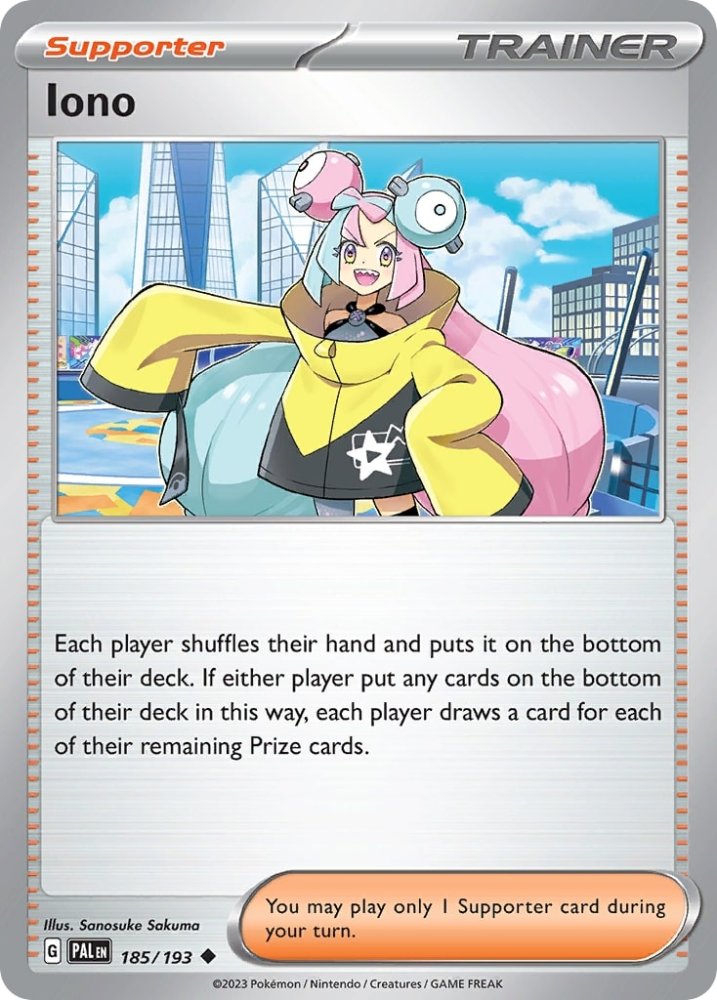
But what if there was a version which combined the best aspects of each? Enter Hybrid Mew. The name sounds fancier than what it really is: DTE Mew with one or two Fusion Strike Energy, used not to power up Meloetta or Eiscue, but simply as insurance against Spiritomb. This simple idea dates back to San Antonio Regionals, back in December, but it has yielded some impressive results and I’m convinced that it’s the next direction (and perhaps the ultimate evolution) of Mew VMAX decks.
In San Antonio, a few players made day 2 with a Mew VMAX list that included Fusion Strike Energy. The highest ranking of them was Andrew Hedrick, who made top 16 with it, although he credits the Fusion Strike Energy decision to Dalton Cross, who made day 2 with a similar list (only one card off), also used by world champion Vance Kelley.
In the Senior division, two players made top 8 with a slightly different version, which had two Fusion Strike Energy as well as Elesa’s Sparkle.
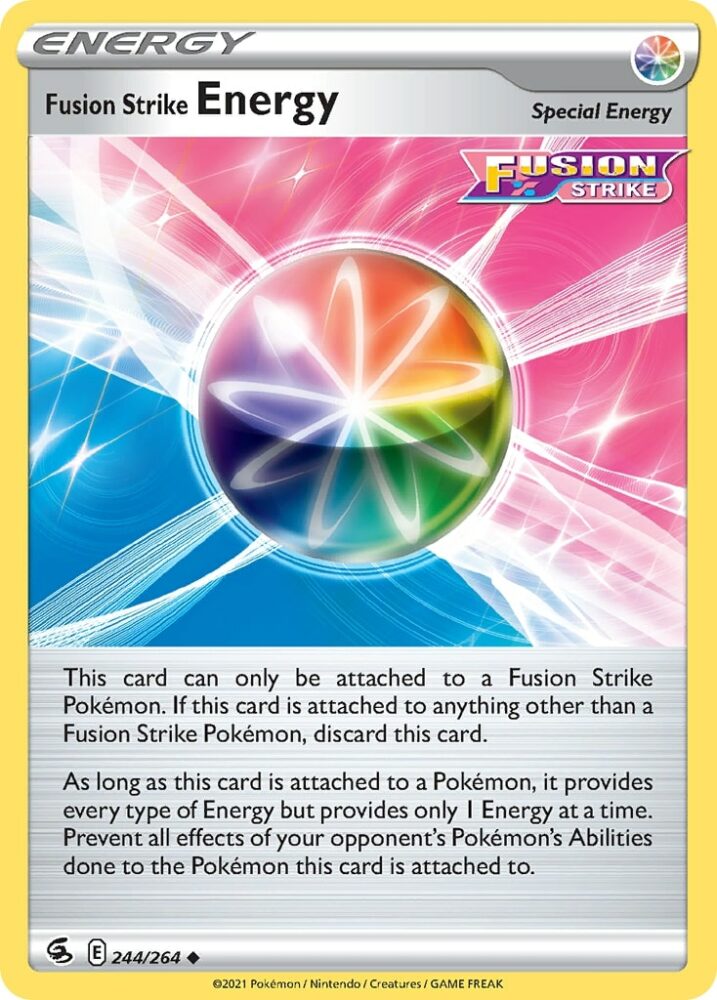
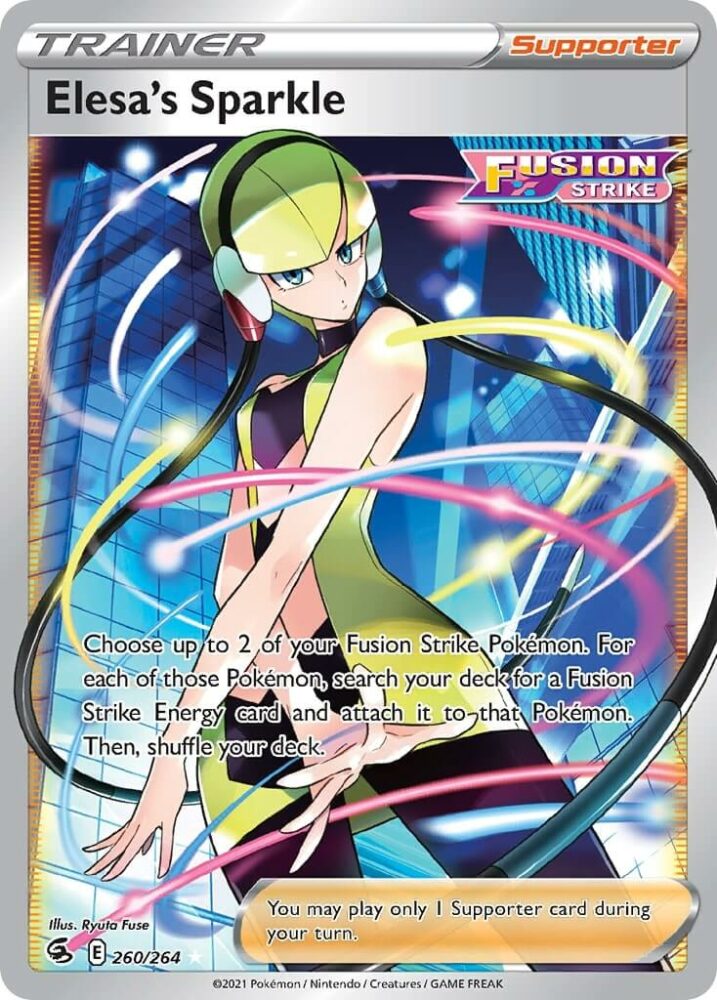
This new version found more success in Portland. Ian Robb made top 8 with it, and Vance Kelley got top 16. I think that it’s interesting to see well-known players do well with this list. One issue with DTE Mew was that due to its weakness to Spiritomb, even strong players could lose just to a turn 1 Spiritomb. Having Fusion Strike Energy in the list doesn’t solve everything (you still need to find it, and you’ll likely have to use your Forest Seal Stone to do so, unless you can hit heads on a Cram-o-matic; and your draw power will still be limited if you don’t get rid of Spiritomb), but it can still be enough against decks that are usually good matchups, and that can be lost only due to Spiritomb, such as Rapid Strike Urshifu VMAX / Inteleon VMAX.
The data suggests that Fusion Strike Energy, as a 1- or 2-of, is a real improvement to DTE Mew VMAX. Japanese player Shota Hirota (who had already made top 8 at Champions League Niigata back in May) got 4th place at Champions League Kyoto, one week after San Antonio, and his list included two Fusion Strike Energy (but no Elesa’s Sparkle). He was the only Mew player to make top 16 at the event. Even in online tournaments, the most successful DTE Mew players since San Antonio have all ran one or two Fusion Strike Energy in their lists.
Building the deck
Mew VMAX decklists are fairly uniform by now. There is some slight variation, but overall, this 58-card skeleton is very standard:
| Pokemon | Trainers | Energy |
|---|---|---|
| 4 Mew V CRZ 60 | 3 Judge SVI 176 | 4 Double Turbo Energy BRS 151 |
| 3 Mew VMAX FST 114 | 2 Boss’s Orders PAL 172 | 1 Fusion Strike Energy FST 244 |
| 4 Genesect V FST 185 | 1 Iono PAL 185 | |
| 4 Power Tablet FST 236 | ||
| 4 Battle VIP Pass FST 225 | ||
| 4 Ultra Ball SVI 196 | ||
| 4 Cram-o-matic FST 229 | ||
| 4 Lost Vacuum CRZ 135 | ||
| 2 Switch Cart ASR 154 | ||
| 1 Escape Rope BST 125 | ||
| 1 Hisuian Heavy Ball ASR 146 | ||
| 1 Feather Ball ASR 141 | ||
| 1 Nest Ball SVI 181 | ||
| 1 Pal Pad SVI 182 | ||
| 3 Forest Seal Stone SIT 156 | ||
| 2 Box of Disaster LOR 154 | ||
| 1 Choice Belt PAL 176 | ||
| 3 Path to the Peak CRE 148 |
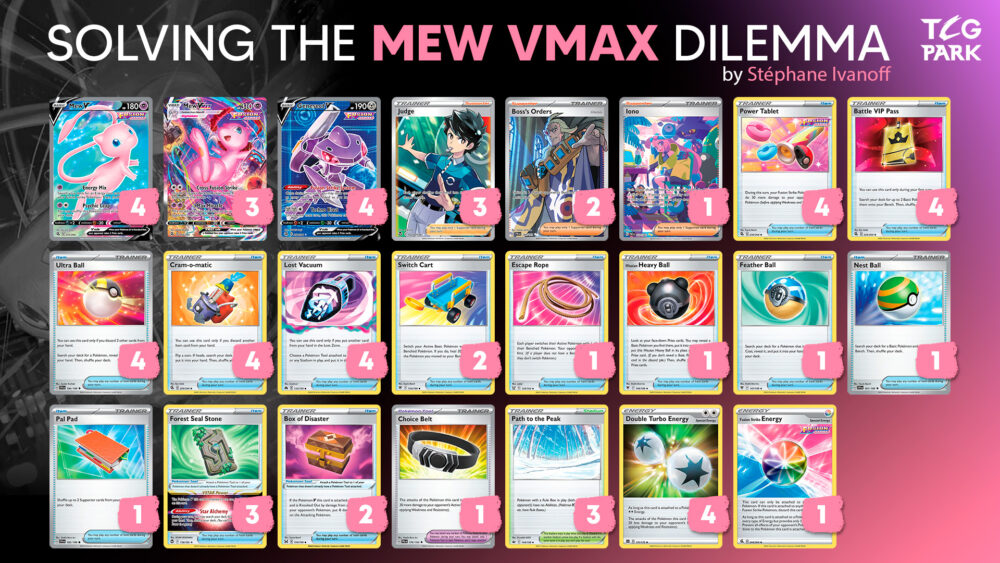
Some slight variations are possible, such as changing the counts of Switch Cart and Escape Rope, or cutting one Forest Seal Stone for a Town Store, but almost every Hybrid Mew will have this structure. You could maybe cut Hisuian Heavy Ball if you need a spot, but I recommend keeping this 58-card basis if you’re building the deck.
This leaves only two cards to choose. That’s usually the hardest part! Here are some choices:
- 2nd Fusion Strike Energy: Having a second copy will make the deck better against Spiritomb, as you can protect a second Genesect and make the deck work normally. That said, remember that Fusion Strike Energy has to be a manual attachment, and Double Turbo Energy usually takes priority as you need that to attack. Also, Fusion Strike Energy can clog your hand, so it’s a bit clunky.
- Elesa’s Sparkle: If you’re playing two Fusion Strike Energy, you can include Elesa’s Sparkle to help attach both to Genesect V. It also lets you attack with Mew V’s Psychic Leap on turn 1 sometimes. I would recommend this build only if you’re especially worried about Spiritomb.
- 4th Path to the Peak: As I mentioned earlier, Path is a great card against a majority of the metagame, and having four copies can be good, especially against Charizard ex. Having played with four copies for a while, though, I think that it’s a bit too much. Path to the Peak can’t be played except at the end of your turn (unless you don’t need it and are willing to use Lost Vacuum on it just afterwards, but then you can’t play down another Path later in the turn), so it can clog your hand and limit your draw power. Also, I’ve found that three copies is usually enough, even in matchups where it’s important. Finally, Giratina VSTAR is on the rise right now, and that’s a matchup in which Path is useless, so I wouldn’t recommend it.
- 2nd Nest Ball / 2nd Feather Ball: More consistency options. Fairly self-explanatory. Not a bad choice, but also not the most impactful.
- Grabber: This is currently my favorite option. Having a bit more disruption fits the deck well, and unlike Path to the Peak, Grabber can always be played if you need to thin your hand. Even when removing a Pokémon from your opponent’s hand doesn’t matter, seeing their hand can give you a lot of information. For example, there was a game I played recently against Chien-Pao ex / Baxcalibur, in which I was behind, but seeing my opponent’s hand showed me that they had no way to KO me if I KO’d Bibarel on that turn, and I managed to turn the game around because of that. Grabber can also slow down Gardevoir decks in the early game.
- Technical Machine Devolution: A tech for Charizard ex. If you can’t KO a Charizard ex after it attacked (for example if it managed to do so by removing your Box of Disaster), use Devolution to send it back to your opponent’s hand, forcing them to have the Rare Candy.
- Cleansing Gloves: Another Tool option, which has some popularity in Japan. Cleansing Gloves is useful against against Mew VMAX and Gardevoir ex, and also lets you KO some small Pokémon like Comfey, Sableye, and Ralts with Psychic Leap without using Power Tablet, so you can hide your Mew VMAX in the deck. Note that if you’re running this kind of Tool, you can cut a Forest Seal Stone for a Town Store, as mentioned earlier.
- Avery: Some Mew VMAX decklists have been running Avery for a while; it’s mostly useful against Gardevoir and Lost Zone decks, as well as the mirror match.
- Professor Turo’s Scenario: Another card that has seen some success in Mew VMAX recently, Turo lets you recover a damaged Mew VMAX, reuse a Genesect V’s Ability, or even make space for a third Mew on your board if you Benched four Genesect, so that you can use Psychic Leap.
Conclusion
Many signs point to Hybrid Mew being the best version of Mew VMAX right now, and it’s one of the decks I’m considering for Liverpool Regionals. That said, it’s also possible that the metagame hasn’t fully caught up with it. Fusion Strike Energy is a good enough counter to Spiritomb in some decks, but it probably wouldn’t be enough to beat Giratina with Spiritomb… but then again, Mew is only a small part of the metagame, so most decks have no reason to devote too much space to that matchup.
Thanks for reading as always,
Stéphane